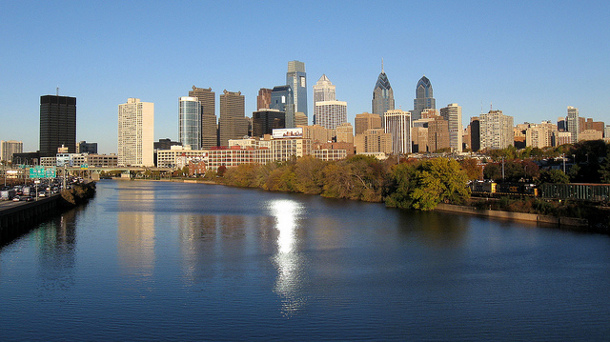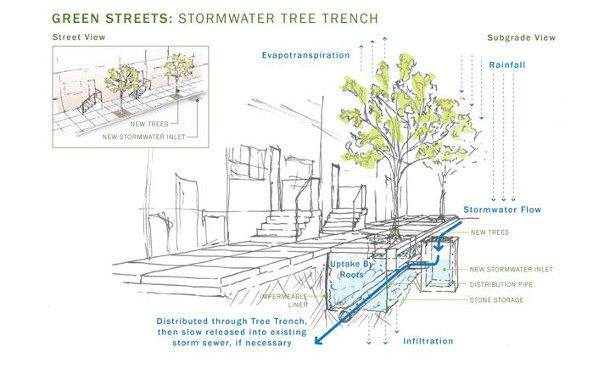Philadelphia has received a great deal of praise for its commitment to using green infrastructure techniques and its 25-year Green City, Clean Waters plan “to protect and enhance our watersheds by managing stormwater with innovative green infrastructure.” But the city’s draft Complete Streets Handbook, released by the Street Department and Mayor’s Office of Transportation and Utilities (they are accepting public comments through November 1st), does not reflect an adequately rigorous understanding, approach, or mandate to integrate green infrastructure design values in to its streets. Here is a breakdown of our comments on the portions of the draft that deal with the treatment of trees, soil, and stormwater.
4.4.7: Street Trees & Tree Trenches
This entire section is only a page long, which is an objection in itself. But we have some more specific issues, too.
First, the following is listed under “Considerations”: “Walkable tree grates, permeable pavers, and structural soil should be used and maintained to ensure that tree pits do not create pinch points or tripping hazards.”
If the purpose is to not create tripping hazards or pinch points, walkable tree grates and permeable pavers can be a great solution. However, structural soil is a completely unrelated product. It is meant for use under paving and does not allow pedestrians to walk across it in a tree opening like the other two options do.
Under “Design,” the handbook gives only a brief explanation: “Tree pit and trench dimensions vary depending upon site conditions. Standard width for tree wells is 4’ from the face of the parallel curb, required minimum tree pit size is 3’ x 3’.”
A typical street tree only has access to the soil within the tree opening; a 3’ x 3’ tree pit can reasonably be expected to provide as little as 27 cubic feet of soil per tree – about three percent of what we would recommend. Since the long-term performance and health of the tree depends on access to soil, small pits – without any access to soil underneath the paving – means that these trees won’t thrive over the long term, and their replacement cycle will be short. This creates significant expense for the city without any of the long-term monetary benefits of healthy, mature trees. A more productive approach would specify a minimum soil volume per street tree, something other cities in North America have already started to do. The minimums vary, but we recommend 1,000 cubic feet of soil volume per tree if in a single planter, or 600 to 750 cubic feet of soil if two trees are sharing one.
The “Street Trees and Tree Trenches” section also includes a category called “Green Street Opportunities,” but all it says is “Stormwater tree pits and trenches should be considered (see sidebar and Green Street Design Manual).” This language is a little worrying; a complete streets handbook should have stronger guidelines and language than “considered.” I’m not optimistic that many developers will implement something like a stormwater tree pit or trench if it is only listed as a consideration. Furthermore, many designers and developers don’t have training in green infrastructure or designing for long-term tree growth. The handbook should explain the relationship between stormwater management, trees, and soil so that adopters understand how each element interacts with the others.
Stormwater Tree Trenches:
The Stormwater Tree Trench sidebar that is mentioned above doesn’t add much insight, including only one illustration and a short paragraph of explanation.
This illustration is a useful starting point, but remains a vast oversimplification of the most salient points about why stormwater tree trenches work, what they can accomplish, and the fundamentals of effective design. The text accompanying this illustration, taken from phillywatersheds.org, says, “A stormwater tree trench is a system of trees that are connected by an underground infiltration structure… This system is composed of a trench dug along the sidewalk, lined with a permeable geotextile fabric, filled with stone or gravel, and topped off with soil and trees. Stormwater runoff flows through a special inlet (storm drain) leading to the stormwater tree trench. The runoff is stored in the empty spaces between the stones, watering the trees and slowly infiltrating through the bottom. If the capacity of this system is exceeded, stormwater runoff can bypass it entirely and flow into an existing street inlet.”
This description – particularly the “topped off with soil and trees” – is frustrating. It suggests that soil and trees are simply minor final additions and that the gravel will do the heavy lifting – but gravel doesn’t grow trees, and bioretention soil mixes do an excellent job managing runoff from daily rainfall events (<2”). A thorough discussion of stormwater tree trenches should include references to soil mixes and types, how trees and soil intercept, evapotranspire, and infiltrate water, percolation rate requirements or targets, soil volume recommendations, a discussion of getting water in to and out of the system, maintenance considerations, and clear engineering standards that any product or system should be able to meet.
Section 4.4.8: Planters
The handbook’s discussion of planters, on page 91, lists standard planting widths, but as with the tree trenches and stormwater trenches sections, there is no discussion of minimum soil volumes. While trees in planters will certainly be receiving more soil than trees in individual sidewalk tree pits, not mandating a minimum amount of soil per tree will ultimately this will limit their mature size and ecological contribution.
The term “green infrastructure” comprises many different design solutions, but at their core, all of them deal with the integration of plants, soils, and stormwater. This trifecta is the basis of creating effective designs that are based on functions that occur in nature. In ultra-urban areas, where open planters, gardens and swales are often unrealistic, much of this needs to happen beneath paving. Without the foundation of soil, there can be no reasonable expectation that green infrastructure solutions – especially those that include trees – will be successful. Without requirements – not recommendations – there can also be no reasonable expectation that these solutions will be implemented by designers, developers, and municipalities on a large scale. According to the Philly Watersheds website, the green streets program “should result in setting a “green standard” for streets within the City.”
You can read more about Philadelphia’s green streets efforts here.
Flickr credit: Pauline Rosenberg







Leave Your Comment